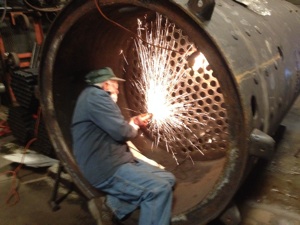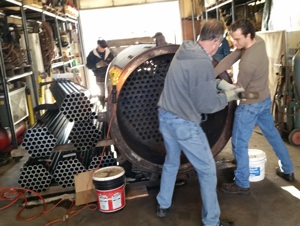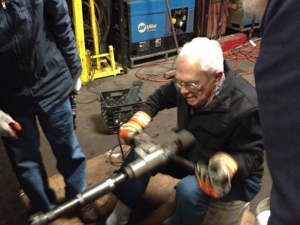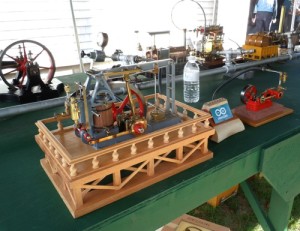Steaming into the Future
After successful spring, summer, and fall seasons at the museum, concluding with Steam-Up on October 17, 2015, the decision was made that it was time for a thorough inspection and possible refurbishment of the Eclipse Lookout boiler, our primary steam source. Our boiler started life on a barge powering a pile driver in the bay. When the construction project was finished, the owners donated the boiler to the museum thanks to the encouragement of Charles Arthur Moore III, the owner of the Apponaug Color Shop. (photos) After operation for several years, the boiler was re-tubed 15 years ago. Now it was decided to take it to a boiler shop.
We asked Chris Riggs, president of AD&D Welding and Boiler Works in Pontiac and a long time supporter of the museum to take care of inspection and repair. The boiler shell itself is 4’ diameter and 10’ long , weighs 2 tons. To move the boiler to the shop, George Kudlak, Art Post and Lou Vertefeuille made a sturdy crib to hold the boiler horizontally; a crane was hired to load the boiler on the crib, which was placed on a lift bed truck donated by Slater’s Exeter Auto Repair. (photos)

At the shop, inspection showed the shell and tube sheets in excellent condition, but all 225 tubes needed to be replaced. Boiler tubes, which are relatively thin compared to the shell and tube sheets, provide two important functions: to transfer heat from the flue gas to the water in the boiler, and to “stay” that is to prevent the tube sheets from buckling out by the pressure of the steam in the boiler. To lock the tubes in place and act as a “stay” the tubes are expanded tightly in the holes in the tube sheet and the ends of the tubes are rolled over to form a physical stop.
Chris’s crew removed the rolled over ends of the tubes and prepared them to be driven out. Then the Thursday working group of volunteers began removing the tubes:

A worker stationed at one end would drive the tube out using a 2 foot long forked end special tool and a ten-pound sledge. Another worker would finish pulling the tube at the other end. Intensive labor with many rest periods ruled the day. Chris’s crew made minor repairs to the tube sheets. The volunteers polished all 450 holes to insure proper fit for the new tubes and then loaded all the rest.

Chris’s crew trimmed the tubes to the proper length then expanded and rolled the tubes with a large, heavy electrically powered tool, much like an oversized electric drill. Our guys rolled some of the tubes. Afterwards, a successful hydro test was made. The completed boiler was inspected by the RI Chief Boiler Inspector then moved back to the museum and returned to it’s base.
Thanks for all who pitched in, Chris Riggs and his staff at AD&D Welding and Boiler Works, Slater’s Exeter Auto Repair, and Ken Adams, Jeff Berry, Dave Caldwell, Errol Groff, Paul Hagist, Warren Hagist, Fred Jaggi, George Kudlak, Craig Moody, Tom Patterson, Art Post, Eric Seamans, Joe Smith, Bob Snow, Randy Snow, Tim Straw, Mike Thompson, Al Thurn, Lou Vertefeuille.
Visit to the Pratt Institute

Last winter, 11 of us visited the Pratt Institute in Brooklyn NY, near the Brooklyn Navy yard. The Institute has a power plant dating from the late 19th century, which has been designated an ASME national landmark. Pratt is a leading art and design college, which had an engineering school until the 1990’s.
The plant provided power to the institute from 1887 through the 1970’s. The oldest units are 3 reciprocating steam engines direct connected to dc generators installed in 1900. The engines can operate but the generators are disconnected.

The plant’s chief engineer, Conrad Milster, gave us a very detailed tour of his facility. He’s been chief for nearly 60 years. Here he is showing us the main pressure regulator controlling steam pressure to all the buildings of the institute. This regulator has been operating since the plant was built.
Further photos and information about the power plant and Mr. Milster can be seen in an article Top of Form by Jake von Slatt.
The Story of Radar
Two fascinating books about the development of radar.
Tuxedo Park. A Wall Street Tycoon and the Secret Palace of Science That Changed the Course of World War II. By Jennet Conant. How Alfred Loomis, a banker and amateur scientist, established the WWII Radar Lab at MIT and funded Ernest Lawrence’s research in nuclear fission. (Read more)
The Invention that Changed the World. How a Small Group of Radar Pioneers Won the Second World War and Launched a Technological Revolution. By Robert Buderi.
If you can’t get these books at the library, they are easily and cheaply available at Abe Books or Alibris
Making a Gift

We are a 501(c)3 public, non-profit engineering museum entirely supported by your generous gifts and our programs. This museum is operated entirely by volunteers. Our exhibits give tangible examples of how the product of rational science and mathematics make a better world. Your donations may be mailed to NEWSM, 1300 Frenchtown Road, E. Greenwich RI 02818, or make a gift online here. Thank you for your loyal support.